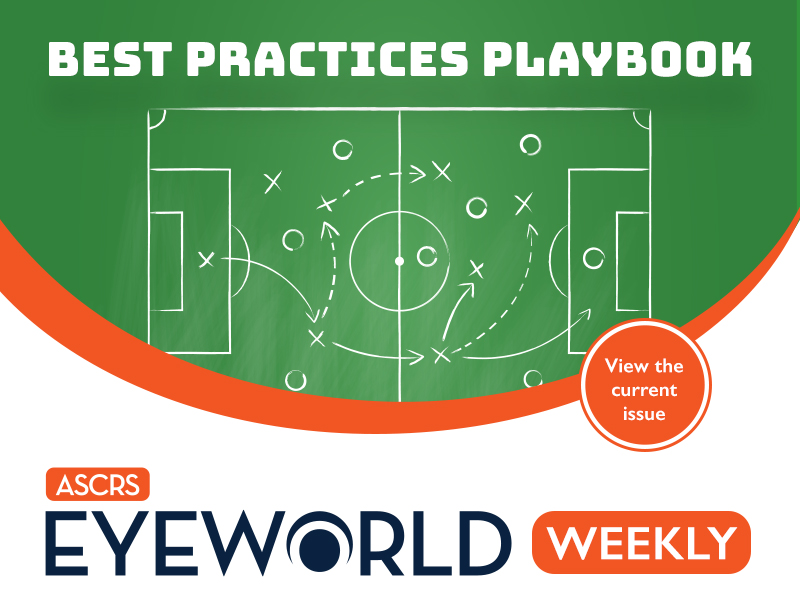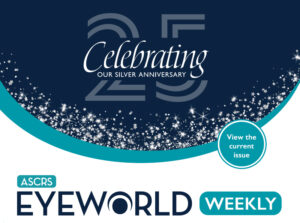FDA approves first treatment targeting Demodex
Tarsus Pharmaceuticals announced FDA approval of XDEMVY (lotilaner ophthalmic solution, formerly TP-03) for treatment of Demodex blepharitis. According to the company, this is the first and only FDA-approved treatment that targets Demodex mites, which are the cause of this blepharitis. The company reported this approval was based on two randomized clinical trials that included 833 patients, 415 of whom received the XDEMVY treatment. The treatment or vehicle (control) was dosed twice daily in each eye for 6 weeks. Patients in the treatment group saw a reduction in collarette numbers (2 or fewer by day 43), and mite eradication and erythema cure were significantly improved at day 43 as well. Adverse reactions included stinging and burning at the instillation site in 10% of patients; less than 2% of patients experienced chalazion/hordeolum and punctate keratitis.
Phase 1 study compares mechanical dry eye treatment to drop therapy
Sight Sciences announced positive results from its Phase 1 randomized clinical trial that compared TearCare, a heat therapy for patients with evaporative dry eye due to MGD intended for use with manual gland expression, to Restasis (cyclosporine ophthalmic emulsion, Allergan). According to the company’s press release, TearCare showed improved tear breakup time compared to Restasis at 6 months. TearCare was also non-inferior to Restasis in OSDI scores at the 6-month endpoint. The press release reported “clinically and statistically significant improvements of every endpoint and at every measurement interval,” including tear breakup time, meibomian gland scores, corneal staining, and conjunctival staining. Symptom endpoints evaluated included OSDI and the Symptom Assessment in Dry Eye. The company stated that this trial is a “first of its kind head-to-head, device versus drug RTC designed to compare the effectiveness of interventional eyelid procedures enabled by TearCare to twice daily Restasis.” The trial enrolled 345 patients at 25 sites in 14 states. Final results from the trial are expected in 2024.
Topical gene therapy for rare ocular surface condition
A patient with dystrophic epidermolysis bullosa (DEB) with recurrent cicatrizing conjunctivitis has been successfully treated with a topical gene therapy under compassionate use approval. According to a news article published by the University of Miami’s UHealth Collective, a 14-year-old boy went from hand-motion vision to 20/25 after topical beremagene geperpavec (B-VEC), which is being developed by Krystal Biotech. According to the company’s press release earlier this year after a presentation about this case, the patient first had surgical symblepharon lysis with pannus removal in the right eye. This was followed by B-VEC use and regular post-surgical management. Full corneal healing was observed by 3 months, and the patient was 20/40 after 7 months of B-VEC use. B-VEC has an FDA and EMA orphan drug designation for the treatment of DEB and an FDA fast-track designation, rare pediatric disease designation, and is considered a regenerative medicine advanced therapy by the FDA.
Glaucoma drug licensed for commercialization in U.S.
Visiox Pharma announced that it received exclusive rights from Santen to manufacture and commercialize OMLONTI (omidenepag isopropyl ophthalmic solution). This drug was approved by the FDA in September 2022 for reduction of IOP in patients with primary open angle glaucoma or ocular hypertension. According to the company’s press release, Visiox will launch OMLONTI in the U.S. in early 2024. As part of the terms of this licensing agreement, Santen will receive equity stake in Visiox and is eligible to receive sales milestone payments and royalties on net sales of OMLONTI, the company’s press release stated.
ASCRS news and events
- ASCRS Summer Meeting: Save your seat at the ASCRS Summer Meeting in Nashville, Tennessee, August 11–13.
- ASCRS Podcast: The latest episode of Ophthalmology Quicksand Chronicles—Eureka Moments, featuring guest Steven Safran, MD, is online now.
- ASCRS Annual Meeting: The call for submissions for the 2024 ASCRS Annual Meeting is going on now through October 9. Find submission details here.
Research highlights
- A prospective, multicenter, controlled, double-masked, and randomized study published in the Journal of Cataract & Refractive Surgery evaluated safety and efficacy of a new cohesive ophthalmic viscosurgical device (StableVisc, Bausch + Lomb), designed to provide mechanical and chemical protection, compared to another cohesive OVD (ProVisc, Alcon). The researchers randomized 390 patients having cataract surgery to receive StableVisc (187) or ProVisc (193) during the procedure. In the area of mean endothelial cell density loss from baseline to 3 months postop, StableVisc was found to be non-inferior to ProVisc (17.5% and 16.9%, respectively). It was also non-inferior when comparing number of patients having a postop IOP of 30 mm Hg or more at any follow-up visits (5.2% vs. 8.2%, respectively). The authors concluded that StableVisc is “safe and effective,” providing surgeons with a new cohesive OVD option.
- Research published in JAMA Ophthalmology compared patient access to laser eye surgery as investigators sought to understand whether expanding laser eye surgery privileges to optometrists would be associated with improved patient access. The study authors wrote that while some states have already granted these privileges to optometrists, “whether these changes are associated with increased access to these procedures among each state’s Medicare population has not been evaluated.” The authors compared access to laser eye surgery in a retrospective cohort database study using Medicare Part B claims from 2016–2020 for patients needing laser eye surgery (laser peripheral iridotomy, selective laser trabeculoplasty, YAG) from optometrists or ophthalmologists in the following states: Oklahoma, Kentucky, Louisiana, Arkansas, and Missouri. The authors found that optometrists performing laser eye surgery covered a similar geographic area to that covered by ophthalmologists. They wrote that less than 5% of the population only had access to optometrists with no ophthalmologists within a 30-minute driving distance for YAG and SLT in every state except Oklahoma. In Kentucky, the authors wrote that patients had to drive farther to access laser procedures from optometrists vs. ophthalmologists. The authors concluded that the expansion of these surgical privileges to optometrists did not lead to shorter travel times for patients to receive care or a “meaningful increase in the percentage of the population with nearby healthcare professionals.”
Product news
- The FDA granted an orphan drug designation to DORC for its dual combination stain Trypan Blue 0.15% and Brilliant Blue G Ophthalmic Solution 0.025% for selective staining of the epiretinal membrane and internal limiting membrane, distinguishing these membranes for removal.
This issue of EyeWorld Weekly was edited by Stacy Jablonski, Liz Hillman, and Ellen Stodola.
EyeWorld Weekly (ISSN 1089-0319), a digital publication of the American Society of Cataract and Refractive Surgery (ASCRS), is published every Friday, distributed by email, and posted live on Friday.
Medical Editors: Sumit “Sam” Garg, MD, Chief Medical Editor, Mitchell Weikert, MD, Cataract Editor, Karolinne Rocha, MD, PhD, Refractive Editor, Julie Schallhorn, MD, Cornea Editor, Manjool Shah, MD, Glaucoma Editor
For sponsorship opportunities or membership information, contact: ASCRS • 12587 Fair Lakes Circle • Suite 348 • Fairfax, VA 22033 • Phone: 703-591-2220 • Fax: 703-591-0614 • Email: ascrs@ascrs.org
Mention of products or services in EyeWorld Weekly does not constitute an endorsement by ASCRS.
Click here to view our Legal Notice.
Copyright 2023, EyeWorld News Service. All rights reserved.



